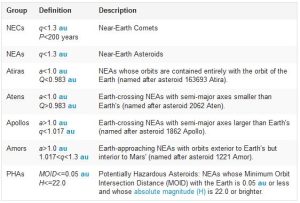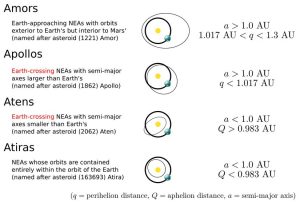According to the United Nations Office for Outer Space Affairs, Near-Earth Objects, or NEOs, represent potentially catastrophic threats to our planet. A near-Earth object is an asteroid or comet which passes close to the Earth’s orbit. In technical terms, a NEO is considered to have a trajectory which brings it within 1.3 astronomical units of the Sun and hence within 0.3 astronomical units, or approximately 45 million kilometers, of the Earth’s orbit. NEOs generally result from objects that have experienced gravitational perturbations from nearby planets, moving them into orbits that allow them to come close to the Earth.
Potentially Hazardous Asteroids, or PHAs, are currently defined based on parameters that measure the asteroid’s potential to make threatening close approaches to the Earth. Specifically, all asteroids with an Earth Minimum Orbit Intersection Distance (MOID) of 0.05 au or less and an absolute magnitude (H) of 22.0 or less are considered PHAs. In other words, asteroids that can’t get any closer to the Earth (i.e., MOID) than 0.05 au (roughly 7,480,000 km or 4,650,000 mi) or are smaller than about 140 m (~500 ft) in diameter (i.e., H = 22.0 with assumed albedo of 14%) are not considered PHAs.








One Response